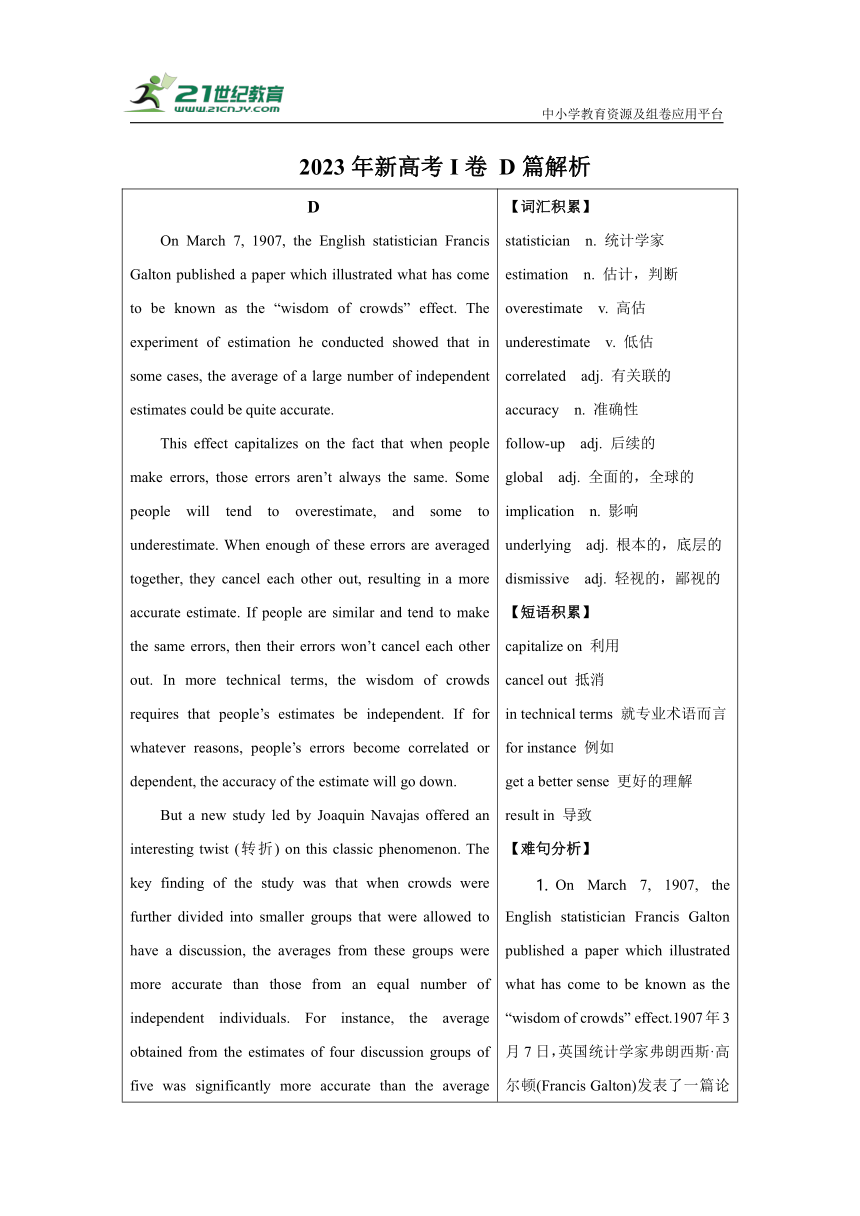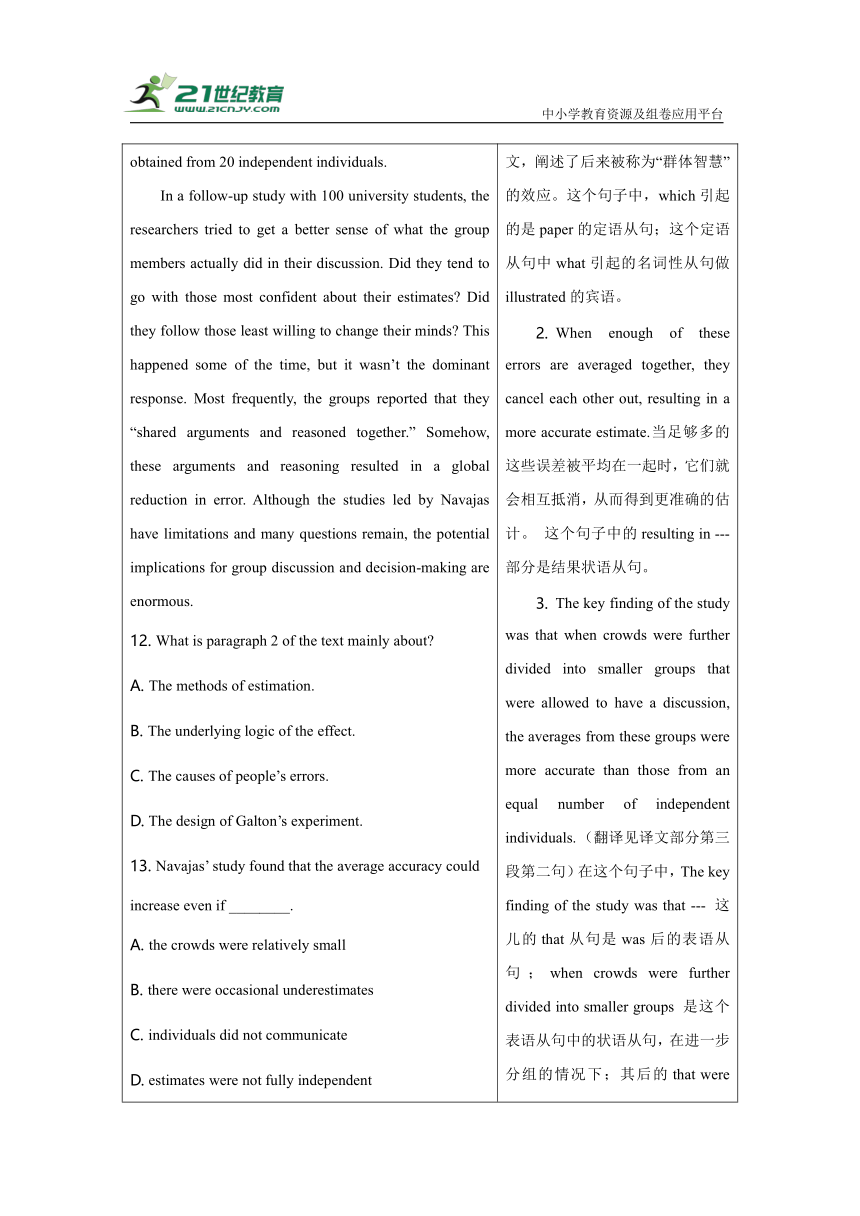2023年高考英语真题(新高考I卷)阅读理解D篇 解读分析 学案
文档属性
| 名称 | 2023年高考英语真题(新高考I卷)阅读理解D篇 解读分析 学案 |

|
|
| 格式 | doc | ||
| 文件大小 | 159.2KB | ||
| 资源类型 | 试卷 | ||
| 版本资源 | 人教版(2019) | ||
| 科目 | 英语 | ||
| 更新时间 | 2023-06-24 18:44:54 | ||
图片预览


文档简介
中小学教育资源及组卷应用平台
2023年新高考I卷 D篇解析
DOn March 7, 1907, the English statistician Francis Galton published a paper which illustrated what has come to be known as the “wisdom of crowds” effect. The experiment of estimation he conducted showed that in some cases, the average of a large number of independent estimates could be quite accurate.This effect capitalizes on the fact that when people make errors, those errors aren’t always the same. Some people will tend to overestimate, and some to underestimate. When enough of these errors are averaged together, they cancel each other out, resulting in a more accurate estimate. If people are similar and tend to make the same errors, then their errors won’t cancel each other out. In more technical terms, the wisdom of crowds requires that people’s estimates be independent. If for whatever reasons, people’s errors become correlated or dependent, the accuracy of the estimate will go down.But a new study led by Joaquin Navajas offered an interesting twist (转折) on this classic phenomenon. The key finding of the study was that when crowds were further divided into smaller groups that were allowed to have a discussion, the averages from these groups were more accurate than those from an equal number of independent individuals. For instance, the average obtained from the estimates of four discussion groups of five was significantly more accurate than the average obtained from 20 independent individuals.In a follow-up study with 100 university students, the researchers tried to get a better sense of what the group members actually did in their discussion. Did they tend to go with those most confident about their estimates Did they follow those least willing to change their minds This happened some of the time, but it wasn’t the dominant response. Most frequently, the groups reported that they “shared arguments and reasoned together.” Somehow, these arguments and reasoning resulted in a global reduction in error. Although the studies led by Navajas have limitations and many questions remain, the potential implications for group discussion and decision-making are enormous.12. What is paragraph 2 of the text mainly about A. The methods of estimation.B. The underlying logic of the effect.C. The causes of people’s errors.D. The design of Galton’s experiment.13. Navajas’ study found that the average accuracy could increase even if ________.A. the crowds were relatively smallB. there were occasional underestimatesC. individuals did not communicateD. estimates were not fully independent14. What did the follow-up study focus on A. The size of the groups.B. The dominant members.C. The discussion process.D. The individual estimates.15. What is the author’s attitude toward Navajas’ studies A. Unclear.B. Dismissive.C. Doubtful.D. Approving. 【词汇积累】statistician n. 统计学家 estimation n. 估计,判断 overestimate v. 高估underestimate v. 低估correlated adj. 有关联的 accuracy n. 准确性 follow-up adj. 后续的 global adj. 全面的,全球的 implication n. 影响underlying adj. 根本的,底层的dismissive adj. 轻视的,鄙视的【短语积累】capitalize on 利用 cancel out 抵消 in technical terms 就专业术语而言 for instance 例如 get a better sense 更好的理解 result in 导致 【难句分析】On March 7, 1907, the English statistician Francis Galton published a paper which illustrated what has come to be known as the “wisdom of crowds” effect.1907年3月7日,英国统计学家弗朗西斯·高尔顿(Francis Galton)发表了一篇论文,阐述了后来被称为“群体智慧”的效应。这个句子中,which引起的是paper的定语从句;这个定语从句中what引起的名词性从句做illustrated的宾语。When enough of these errors are averaged together, they cancel each other out, resulting in a more accurate estimate.当足够多的这些误差被平均在一起时,它们就会相互抵消,从而得到更准确的估计。 这个句子中的resulting in ---部分是结果状语从句。The key finding of the study was that when crowds were further divided into smaller groups that were allowed to have a discussion, the averages from these groups were more accurate than those from an equal number of independent individuals. (翻译见译文部分第三段第二句)在这个句子中,The key finding of the study was that --- 这儿的that从句是was后的表语从句;when crowds were further divided into smaller groups 是这个表语从句中的状语从句,在进一步分组的情况下;其后的that were allowed to have a discussion,是smaller groups的定语从句;the averages from these groups were more accurate --- 是这个表语从句中的主句。简单的句子结构为:The key finding ---was that ---the averages ---were more accurate---.Did they tend to go with those most confident about their estimates 他们倾向于相信那些对自己的估计最有信心的人吗 这个句子中,those 那些人,其后的most confident about their estimates 是形容词短语做定语。
【应试点拨】:1. 这篇文章是一篇科普类说明文。科普类文章的结构清晰,有着明显的因果、转折等逻辑关系。阅读这类文章,一定要注意文章的结构和段落之间的逻辑关系。比如本篇文章,第一段介绍了群体智慧效应:大量独立估计的平均值会相当准确。第二段介绍了群体智慧效应的逻辑基础:误差的相互抵消。第三段介绍了有关群体智慧的新发现:允许讨论的多个小组得到的平均值更准确。第四段介绍了小组讨论的过程:共享论据,共同推理。各段之间的逻辑关系清晰。 2. 在了解段落大意时,要注意段落中层次的逻辑关系。比如第二段的分析和理解: 第一句This effect capitalizes on the fact that when people make errors, those errors aren’t always the same. 是本段的主题句。 第二句和第三句解释了主题句:估计错误的不同和估计误差的相互抵消造成了估计的准确性。第三层从相反假设的情况论述:如果估计不是独立的,错误的类型相同了,没有了误差的互相抵消,估计的准确性会下降。这样的分析段落的方式是也是科普类文章或议论文理解的基本思路。 3. 关于词汇,和前几篇文章中的处理方式类似,不要翻译,不要试图搞清楚每一句话的汉语意思。要从上下文中去领会和掌握句子大意。 4. 对于长句子。要快速的寻找主句的主要结构,先搞清楚主句,再进一步分析定语从句、状语从句等其他句子成分。从简化句子入手,按句子成分的不同级别理解句子的大意,先主句后从句,先局部再整体,不要弄混了各部分的关系。 5. 根据题干和选项中的关键词回到原文确定相关信息的出处,判断原文内容和题干内容是否一致,是否是因果关系。一定要核实到原文相关信息,因为个人的生活经验可能和原文内容不同。 【译文】1907年3月7日,英国统计学家弗朗西斯·高尔顿(Francis Galton)发表了一篇论文,阐述了后来被称为“群体智慧”的效应。他进行的估计实验表明,在某些情况下,大量独立估计的平均值会相当准确。这种效应利用了这样一个事实:当人们犯错误时,这些错误并不总是相同的。有些人倾向于高估,有些人倾向于低估。当足够多的这些误差被平均在一起时,它们就会相互抵消,从而得到更准确的估计。如果人们是相似的,并且倾向于犯同样的错误,那么他们的错误就不会相互抵消。用更专业的术语来说,群体智慧要求人们的估计是独立的。如果由于某种原因,人们的错误变得相关或依赖,估计的准确性就会下降。但是,由华金·纳瓦加斯(Joaquin Navajas)领导的一项新研究为这一经典现象提供了一个有趣的转折。这项研究的关键发现是,当人群被进一步分成更小的群体并允许进行讨论时,这些群体的平均值比同样数量的独立个体的平均值更准确。例如,从4个5人讨论小组中得到的平均值比从20个独立个体中得到的平均值要准确得多。在对100名大学生的后续研究中,研究人员试图更好地了解小组成员在讨论中实际做了什么。他们倾向于相信那些对自己的估计最有信心的人吗 他们追随那些最不愿意改变自己主意的人吗 这种情况有时会发生,但不是主要的回应。最常见的是,这些小组报告说他们“共享论据,一起推理”。不知何故,这些论据和推理导致了错误的全面减少。尽管纳瓦加斯(Joaquin Navajas)领导的研究有局限性,并且许多问题仍然存在,但是这项研究对小组讨论和决策的潜在影响是巨大的。 【答案】12. B 13. D 14. C 15. D【解析】本文是科普类说明文。介绍了“群体智慧”效应:大量独立估计的平均值会相当准确。并且介绍了关于这个效应的新发现:允许讨论的多个小组得到的平均值更准确。【12题详解】主旨大意题。回到原文的第二段,从段落内部层次上去理解段落大意。本段可以简单的分为三层:第一句主题句:这个群体智慧效应的逻辑基础;第二句和第三句细致分析了主题句的内在逻辑;第三层通过假设进一步论证了主题句的内在逻辑。因此可知,本段主要解释了“群体智慧”效应这一现象的基本逻辑。故选B。【13题详解】细节理解题。注意题干:即使是---情况,平均值的准确性也可以提高。 根据题干提示,定位到第三段,注意估计的平均值的准确性提高的情况。本段以But开始,我们要注意和哪些内容产生的转折,并且,第一句话中twist是转折的什么内容。这一段的第一句可以看做本段的第一层,承上启下的导入。第二句是本段的第二层,新发现可以讨论的小组的估计平均值更高,比同等数量的独立个体的平均值更准确。第三句话为本段的第三层,是第二层的例子。因此,即使是非完全独立的估计也可以提高准确性。故选D。【14题详解】细节核对题。根据题干提示的follow-up study定位到第四段。In a follow-up study ---, the researchers tried to get a better sense of what the group members actually did in their discussion. 这句话中的研究目的很明确,就是更好的了解小组成员在讨论中的实际行为。这句话后的部分是为了解情况而提的问题和大学生们的回答。故选C。【15题详解】细节理解题。作者对Navajas的研究的态度体现在最后一段的最后一句:Although the studies --- have limitations ---, the potential implications --- are enormous. 尽管纳瓦加斯领导的研究有局限性,并且许多问题仍然存在,但是这项研究对小组讨论和决策的潜在影响是巨大的。因此推测作者对于Navajas的研究表示出了赞许和支持。故选D。
2023年新高考I卷 D篇解析
DOn March 7, 1907, the English statistician Francis Galton published a paper which illustrated what has come to be known as the “wisdom of crowds” effect. The experiment of estimation he conducted showed that in some cases, the average of a large number of independent estimates could be quite accurate.This effect capitalizes on the fact that when people make errors, those errors aren’t always the same. Some people will tend to overestimate, and some to underestimate. When enough of these errors are averaged together, they cancel each other out, resulting in a more accurate estimate. If people are similar and tend to make the same errors, then their errors won’t cancel each other out. In more technical terms, the wisdom of crowds requires that people’s estimates be independent. If for whatever reasons, people’s errors become correlated or dependent, the accuracy of the estimate will go down.But a new study led by Joaquin Navajas offered an interesting twist (转折) on this classic phenomenon. The key finding of the study was that when crowds were further divided into smaller groups that were allowed to have a discussion, the averages from these groups were more accurate than those from an equal number of independent individuals. For instance, the average obtained from the estimates of four discussion groups of five was significantly more accurate than the average obtained from 20 independent individuals.In a follow-up study with 100 university students, the researchers tried to get a better sense of what the group members actually did in their discussion. Did they tend to go with those most confident about their estimates Did they follow those least willing to change their minds This happened some of the time, but it wasn’t the dominant response. Most frequently, the groups reported that they “shared arguments and reasoned together.” Somehow, these arguments and reasoning resulted in a global reduction in error. Although the studies led by Navajas have limitations and many questions remain, the potential implications for group discussion and decision-making are enormous.12. What is paragraph 2 of the text mainly about A. The methods of estimation.B. The underlying logic of the effect.C. The causes of people’s errors.D. The design of Galton’s experiment.13. Navajas’ study found that the average accuracy could increase even if ________.A. the crowds were relatively smallB. there were occasional underestimatesC. individuals did not communicateD. estimates were not fully independent14. What did the follow-up study focus on A. The size of the groups.B. The dominant members.C. The discussion process.D. The individual estimates.15. What is the author’s attitude toward Navajas’ studies A. Unclear.B. Dismissive.C. Doubtful.D. Approving. 【词汇积累】statistician n. 统计学家 estimation n. 估计,判断 overestimate v. 高估underestimate v. 低估correlated adj. 有关联的 accuracy n. 准确性 follow-up adj. 后续的 global adj. 全面的,全球的 implication n. 影响underlying adj. 根本的,底层的dismissive adj. 轻视的,鄙视的【短语积累】capitalize on 利用 cancel out 抵消 in technical terms 就专业术语而言 for instance 例如 get a better sense 更好的理解 result in 导致 【难句分析】On March 7, 1907, the English statistician Francis Galton published a paper which illustrated what has come to be known as the “wisdom of crowds” effect.1907年3月7日,英国统计学家弗朗西斯·高尔顿(Francis Galton)发表了一篇论文,阐述了后来被称为“群体智慧”的效应。这个句子中,which引起的是paper的定语从句;这个定语从句中what引起的名词性从句做illustrated的宾语。When enough of these errors are averaged together, they cancel each other out, resulting in a more accurate estimate.当足够多的这些误差被平均在一起时,它们就会相互抵消,从而得到更准确的估计。 这个句子中的resulting in ---部分是结果状语从句。The key finding of the study was that when crowds were further divided into smaller groups that were allowed to have a discussion, the averages from these groups were more accurate than those from an equal number of independent individuals. (翻译见译文部分第三段第二句)在这个句子中,The key finding of the study was that --- 这儿的that从句是was后的表语从句;when crowds were further divided into smaller groups 是这个表语从句中的状语从句,在进一步分组的情况下;其后的that were allowed to have a discussion,是smaller groups的定语从句;the averages from these groups were more accurate --- 是这个表语从句中的主句。简单的句子结构为:The key finding ---was that ---the averages ---were more accurate---.Did they tend to go with those most confident about their estimates 他们倾向于相信那些对自己的估计最有信心的人吗 这个句子中,those 那些人,其后的most confident about their estimates 是形容词短语做定语。
【应试点拨】:1. 这篇文章是一篇科普类说明文。科普类文章的结构清晰,有着明显的因果、转折等逻辑关系。阅读这类文章,一定要注意文章的结构和段落之间的逻辑关系。比如本篇文章,第一段介绍了群体智慧效应:大量独立估计的平均值会相当准确。第二段介绍了群体智慧效应的逻辑基础:误差的相互抵消。第三段介绍了有关群体智慧的新发现:允许讨论的多个小组得到的平均值更准确。第四段介绍了小组讨论的过程:共享论据,共同推理。各段之间的逻辑关系清晰。 2. 在了解段落大意时,要注意段落中层次的逻辑关系。比如第二段的分析和理解: 第一句This effect capitalizes on the fact that when people make errors, those errors aren’t always the same. 是本段的主题句。 第二句和第三句解释了主题句:估计错误的不同和估计误差的相互抵消造成了估计的准确性。第三层从相反假设的情况论述:如果估计不是独立的,错误的类型相同了,没有了误差的互相抵消,估计的准确性会下降。这样的分析段落的方式是也是科普类文章或议论文理解的基本思路。 3. 关于词汇,和前几篇文章中的处理方式类似,不要翻译,不要试图搞清楚每一句话的汉语意思。要从上下文中去领会和掌握句子大意。 4. 对于长句子。要快速的寻找主句的主要结构,先搞清楚主句,再进一步分析定语从句、状语从句等其他句子成分。从简化句子入手,按句子成分的不同级别理解句子的大意,先主句后从句,先局部再整体,不要弄混了各部分的关系。 5. 根据题干和选项中的关键词回到原文确定相关信息的出处,判断原文内容和题干内容是否一致,是否是因果关系。一定要核实到原文相关信息,因为个人的生活经验可能和原文内容不同。 【译文】1907年3月7日,英国统计学家弗朗西斯·高尔顿(Francis Galton)发表了一篇论文,阐述了后来被称为“群体智慧”的效应。他进行的估计实验表明,在某些情况下,大量独立估计的平均值会相当准确。这种效应利用了这样一个事实:当人们犯错误时,这些错误并不总是相同的。有些人倾向于高估,有些人倾向于低估。当足够多的这些误差被平均在一起时,它们就会相互抵消,从而得到更准确的估计。如果人们是相似的,并且倾向于犯同样的错误,那么他们的错误就不会相互抵消。用更专业的术语来说,群体智慧要求人们的估计是独立的。如果由于某种原因,人们的错误变得相关或依赖,估计的准确性就会下降。但是,由华金·纳瓦加斯(Joaquin Navajas)领导的一项新研究为这一经典现象提供了一个有趣的转折。这项研究的关键发现是,当人群被进一步分成更小的群体并允许进行讨论时,这些群体的平均值比同样数量的独立个体的平均值更准确。例如,从4个5人讨论小组中得到的平均值比从20个独立个体中得到的平均值要准确得多。在对100名大学生的后续研究中,研究人员试图更好地了解小组成员在讨论中实际做了什么。他们倾向于相信那些对自己的估计最有信心的人吗 他们追随那些最不愿意改变自己主意的人吗 这种情况有时会发生,但不是主要的回应。最常见的是,这些小组报告说他们“共享论据,一起推理”。不知何故,这些论据和推理导致了错误的全面减少。尽管纳瓦加斯(Joaquin Navajas)领导的研究有局限性,并且许多问题仍然存在,但是这项研究对小组讨论和决策的潜在影响是巨大的。 【答案】12. B 13. D 14. C 15. D【解析】本文是科普类说明文。介绍了“群体智慧”效应:大量独立估计的平均值会相当准确。并且介绍了关于这个效应的新发现:允许讨论的多个小组得到的平均值更准确。【12题详解】主旨大意题。回到原文的第二段,从段落内部层次上去理解段落大意。本段可以简单的分为三层:第一句主题句:这个群体智慧效应的逻辑基础;第二句和第三句细致分析了主题句的内在逻辑;第三层通过假设进一步论证了主题句的内在逻辑。因此可知,本段主要解释了“群体智慧”效应这一现象的基本逻辑。故选B。【13题详解】细节理解题。注意题干:即使是---情况,平均值的准确性也可以提高。 根据题干提示,定位到第三段,注意估计的平均值的准确性提高的情况。本段以But开始,我们要注意和哪些内容产生的转折,并且,第一句话中twist是转折的什么内容。这一段的第一句可以看做本段的第一层,承上启下的导入。第二句是本段的第二层,新发现可以讨论的小组的估计平均值更高,比同等数量的独立个体的平均值更准确。第三句话为本段的第三层,是第二层的例子。因此,即使是非完全独立的估计也可以提高准确性。故选D。【14题详解】细节核对题。根据题干提示的follow-up study定位到第四段。In a follow-up study ---, the researchers tried to get a better sense of what the group members actually did in their discussion. 这句话中的研究目的很明确,就是更好的了解小组成员在讨论中的实际行为。这句话后的部分是为了解情况而提的问题和大学生们的回答。故选C。【15题详解】细节理解题。作者对Navajas的研究的态度体现在最后一段的最后一句:Although the studies --- have limitations ---, the potential implications --- are enormous. 尽管纳瓦加斯领导的研究有局限性,并且许多问题仍然存在,但是这项研究对小组讨论和决策的潜在影响是巨大的。因此推测作者对于Navajas的研究表示出了赞许和支持。故选D。
同课章节目录
